This three-dimensional, four-dimensional, multi-dimensional world
Three-dimensional space is a geometric model of the world in which we live. It is called three-dimensional because its description corresponds to three unit vectors having a direction of length, width and height. The perception of three-dimensional space develops at a very early age and is directly related to humans. The depth of his perception depends on the visual ability to understand the surrounding world and the ability to identify three dimensions using the senses.
According to analytical geometry, three-dimensional space at each point is described by three characterizing quantities called coordinates. Coordinate axes located perpendicular to each other at the intersection point form the origin of coordinates, which has a zero value. The position of any point in space is determined relative to three coordinate axes, which have a different numerical value at each given interval. Three-dimensional space at each individual point is determined by three numbers corresponding to the distance from the reference point on each coordinate axis to the point of intersection with a given plane. There are also coordinate schemes such as spherical and cylindrical systems.
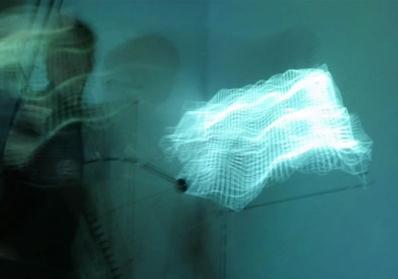
In linear algebra, the concept of three-dimensional measurement is described using the concept of linear independence. Physical space is three-dimensional because the height of any object does not depend in any way on its width and length. In the language of linear algebra, space is three-dimensional because each individual point in it can be defined by a combination of three vectors that are linearly independent of each other. In this formulation, the concept of space-time has a four-dimensional meaning, because the position of a point at different time intervals does not depend on its location in space.

Some properties that three-dimensional space has are qualitatively different from the properties of spaces located in another dimension. For example, a knot tied in a rope is located in a space of lesser dimension. Most physical laws are related to the three-dimensional dimension of space, for example, the inverse square laws. Three-dimensional space can contain two-dimensional, one-dimensional and zero-dimensional spaces, while it itself is considered part of the model
Isotropy of space is one of its key properties in classical mechanics. Space is called isotropic because when the reference system is rotated to any arbitrary angle, the measurement results do not change. The conservation law is based on the isotropic properties of space. This means that in space all directions are equal and there is no separate direction with the definition of independent. Isotropy has the same physical properties in all possible directions. Thus, isotropic space is a medium that does not depend on direction.
A 3D world we don't live in
Even the ancient Greeks transformed mathematics from an empirical science into a deductive one, requiring the derivation of proofs of its statements from basic concepts and eliminating the reference to experience as an argument.
Pure mathematics explores forms and relationships in abstraction from material content. Its immediate object turns out to be, for example, not this or that spherical body, but an “ideal ball”, not this or that collection of objects, and not even individual numbers, but whole numbers in general, etc.
However, for all the abstractness of this science, none of the mathematicians apparently doubted that all their concepts, theorems and formulas express real quantitative and spatial relationships. Mathematical geometry was the theory of real space, just as mechanics was later the theory of motion
Mathematics is the science that studies
quantitative and spatial
forms and relationships of reality
Academician A. D. Alexandrov
The world around us is three-dimensional. We are accustomed to this idea from birth - every person knows what height, length and width are, the three main dimensions of the space around us. Depending on the traditions accepted in different countries, the dimensions of objects are measured in meters, feet, li, leagues and other standard units of length. For our further discussion, we will choose a slightly unusual unit of length. She will be served by one light year(1 St. Year), i.e., the distance traveled by a ray of light in one calendar year. In traditional measures of length, this amounts to an unimaginable value - approximately 9.46 10 12 kilometers.
If we mentally cut out a cube with an edge equal to 1 st. year, then the house in which we live, the globe, will be safely placed inside, solar system... In general, everything that is necessary for a normal human life. For convenience, let's call the cube we considered unit cube. Now let's note the following obvious fact. Despite its enormous size, our single cube is only the smallest particle of the surrounding world.
Such an imaginary unit cube can be cut out at any other point in space. In this case, it can be argued that two cubes cut out at different points in space will turn out to be the same. This is the main idea of the so-called Euclidean manifold, according to which any of its points is surrounded by a cube of appropriate dimensions. The following definition can be formulated more precisely. A three-dimensional Euclidean manifold is a set M 3, any point of which is the center of a cube consisting entirely of points of this set.
By the way, in this definition the dimensions of the cube itself are not specified - it is not at all necessary to use large cubes. With the same success we can say that each point is contained in a cube, the edge of which does not exceed the length of, say, one micron (10 -6 cm).
All of the above can be briefly expressed in the following words: the world around us is a three-dimensional Euclidean manifold. Now let’s try to answer the following question: how does the world work outside the single cube in which our home is located - our Solar system?
Three-dimensional torus and others
If we imagine for a moment that the space around us is infinite in all directions, then the answer to the question about the structure of the world around us will be given by the following Hadamard's theorem:
“A three-dimensional Euclidean manifold infinitely extended in all directions M 3 coincides with Euclidean space E 3».
Euclidean space E 3 with a rectangular coordinate system is well known to everyone, so we will not dwell in detail on studying its properties.
In order to make our reasoning more meaningful and interesting, let’s assume another option: the world around us is closed, that is, it has finite dimensions and has no edge. In other words, let us ask ourselves how closed three-dimensional Euclidean manifolds are structured, or, in other words, Euclidean forms. The complete answer to this question is given by the theorem proved by J. Wolf (1982):
There are exactly ten three-dimensional Euclidean shapes. Moreover, six of them are orientable, and the remaining four are non-orientable manifolds.
All Euclidean shapes are constructed in a similar way, the only thing is that to construct some of them you need to use a cube, and for others you need to use a regular hexagonal prism.
The first and most famous Euclidean form is a kind of analogue of the familiar two-dimensional torus - three-dimensional torus. Let us denote this set (a cube with pairwise identified faces) by T 3. Another Euclidean form is the so-called twisted three-dimensional torus, denoted accordingly as Q 3. Now let’s carry out a simple physical experiment that will show that the varieties T 3 And Q 3 are different, and both differ from Euclidean space E 3.
To do this, in the center of face A of the three-dimensional torus we place spaceship, flying at the speed of light, and make it start in the vertical direction. Exactly one year later, the spacecraft, continuing to move in a straight line, will return to its starting point. Now this point will be located in the center of face A', which, by convention, is identified with face A. As a result of the experiment, we will find that in a three-dimensional torus T 3 there is a closed straight line l one light year long.
Let's perform another similar experiment. Let's make the spaceship launch from point y, lying in the face A at a distance of 1 km from its center. In a year the ship will return safely to the point at. Conclusion from the second experiment - through the point at a closed line 1 light year long passes parallel to the line l.
Now we will carry out both described experiments in a twisted torus Q 3. The first experiment will give exactly the same result as before. However, in the second experiment it will be completely different. A ship starting from a point at, in one year will reach the point z, which lies on the face A’-A and is diametrically opposite to the point at relative to the center of this face. The flight in a straight line will continue for another year, after which the ship will return to the point at.
Thus, in Q 3 through the point at there is a closed line of length 2 parallel to the line l. Therefore, the varieties T 3 And Q 3 are different and both are different from space E 3, in which there are no closed straight lines.
The following Euclidean form is filled Klein bottle(manifold K 3) - unlike the previous ones, it is non-orientable. Let's prove it. To do this, let's repeat the experiment with a spacecraft launching from the center of the face A, but we will additionally equip the nose of the ship with a propeller rotating clockwise at a constant speed (if you observe it from the pilot’s cabin). Let's assume that the ship's fuel supply is large enough and the propeller will rotate for a year until the ship has completed its journey along a closed straight line. l, will return to the starting point. The moment the ship reaches the starting point again, the pilot will be surprised to find that the propeller is rotating counterclockwise! (Of course, this means the watch that the pilot forgot at the start.) The latter means that the variety K 3- non-orientable and, therefore, different from previously constructed Euclidean forms T 3 And Q 3.

In conclusion, we note that the dimensions of the Solar system (its diameter is approximately 124 10 9 km) are small compared to the dimensions of the manifolds constructed above on the basis of a linear cube. It can be located either inside T 3, Q 3, K 3, and in any other Euclidean form. Moreover, to calculate distances not exceeding 1 St. year, we can use ordinary Euclidean geometry and not even realize that the world around us is closed. Currently, humanity does not have spaceships that fly at the speed of light. This means that it is now impossible to carry out global experiments similar to those described above, and, finally, to establish which of the Euclidean worlds we live in.
Manifolds
As already noted, all the manifolds considered above have Euclidean geometry. What does this mean and what other geometries exist?
The most famous and used in universal human practice are Euclidean, spherical And hyperbolic geometry. Recall that spherical geometry is sometimes called Riemann geometry, and hyperbolic - Lobachevsky geometry. In three-dimensional space, in addition to the three indicated, there are five more so-called synthetic geometries.
![]()
In accordance with what geometric laws operate on a three-dimensional manifold, we will call it Euclidean, spherical, hyperbolic or synthetic, respectively.
We have already considered Euclidean manifolds above. As for the rest, more than twenty years ago W. Thurston (1978) proved a remarkable theorem: almost all three-dimensional manifolds are hyperbolic, that is, they obey the laws of Lobachevsky geometry. For this result, in 1983 he was awarded the Fields Medal, the most prestigious award for mathematicians.
Geometry, having arisen on the basis of practical experience, remained essentially a physical theory that received only a strictly deductive form. Physics fully accepted it; no other space other than the three-dimensional Euclidean was thought of in mathematics itself. This was the case until Lobachevsky’s geometry arose, which he himself called “imaginary,” and Lobachevsky’s imaginary space appeared. Then n-dimensional space appeared, and finally, B. Riemann introduced the general concept of mathematical space in the lecture “On the hypotheses underlying geometry,” which he gave back in 1854. Riemann gave general definition spaces in the mathematical sense, including infinite-dimensional "function spaces" whose "points" are functions. He also laid the foundations of the theory of spaces, which later received the name Riemannian and later presented the mathematical apparatus of the general theory of relativity
Spherical manifolds can be either three-dimensional or multidimensional (Wolf, 1982). In a space of any dimension there is a finite number of types of such manifolds. There are very few synthetic manifolds (Thurston, 1978; Dunbar, 1981; Thurston, 2001), in contrast to the remaining class of hyperbolic manifolds. The latter is inexhaustibly broad and its classification has not yet been completed.
Spherical manifolds
All three-dimensional spherical manifolds are orientable. This means that no matter what closed trajectory a spacecraft with a continuously rotating propeller flies, upon returning to the starting point its propeller rotates in the same direction as at the moment of launch.
The simplest spherical manifold is the three-dimensional sphere S 3. It can be defined as the boundary of a four-dimensional ball or, what is the same, as a set of points in space E 4, distant from the center at the same distance. Using stereographic projection, you can establish a one-to-one and mutually continuous correspondence between points of a three-dimensional sphere S 3 and points of the set E 3+ (∞), obtained by adding to the familiar Euclidean space E 3 point at infinity ∞. Thus we can assume that S 3 = E 3 + {∞}.
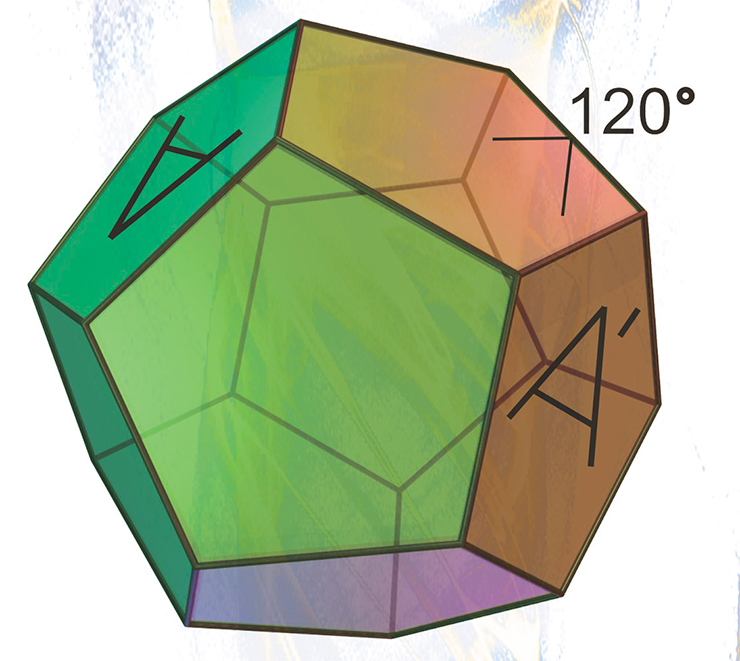
The second example of a spherical manifold is three-dimensional projective space R 3. It can be easily imagined as a ball, the diametrically opposite points of which are identified.
The third, and perhaps the most non-trivial example of a spherical manifold is the spherical space of the Poincaré dodecahedron or, for short, Poincare sphere.
The Poincaré sphere is surprisingly connected with various branches of mathematics - geometry, topology, group theory, catastrophe theory, knot theory and others (Kirby, Charlemagne, 1982).

All other spherical manifolds, obtained according to a single scheme, are the so-called lens And prismatic spaces.
Hyperbolic varieties
The first three-dimensional closed hyperbolic manifold was constructed by the German mathematician F. Lebell in 1931. However, its construction was quite complex, so two years later H. Seifert and C. Weber proposed an elegant construction of the hyperbolic space of the dodecahedron.

From a mathematical point of view, the most difficult part of the construction problem is proving the existence of this hyperbolic dodecahedron in Lobachevsky space. A positive answer to this question is given by the fundamental theorem of E. M. Andreev (1970), which formulates necessary and sufficient conditions for the existence of convex hyperbolic polyhedra. This theorem serves as one of the cornerstones of the modern theory of hyperbolic manifolds, created by W. Thurston.
Constructing manifolds from polyhedra
Consider a rectangular polyhedron P, all of whose dihedral (and plane) angles are equal to 90°. In Euclidean space, we can take a cube as such a polyhedron, in spherical space - a tetrahedron, and in hyperbolic space - hexagonal Lebell prism, the side surface of which consists of 12 pentagons.
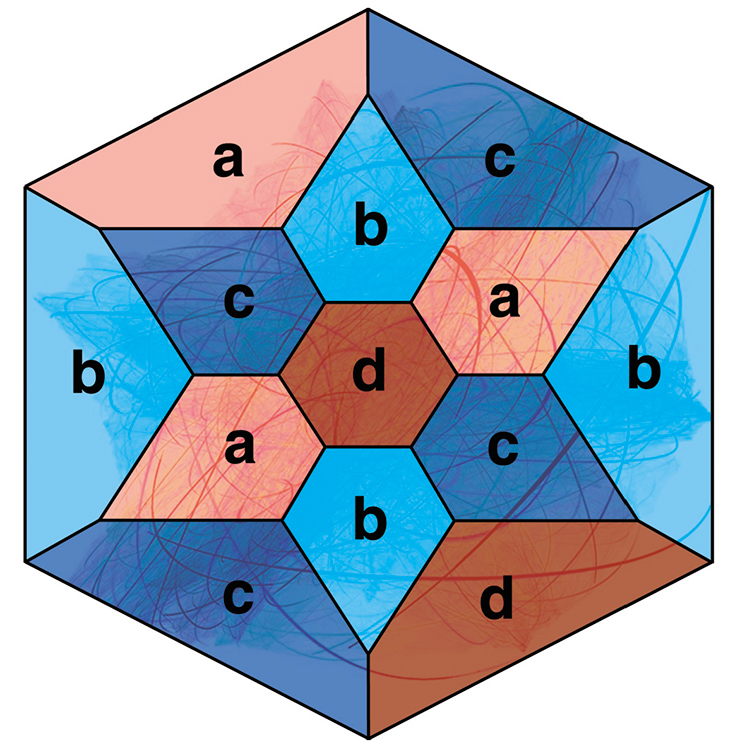
From Andreev’s theorem it follows that any polyhedron that does not have triangular or quadrangular faces, and exactly three edges converge at each vertex, can be realized as a rectangular polyhedron in Lobachevsky space. The hexagonal Lebell prism obviously satisfies these conditions.
To construct hyperbolic manifolds, a method is used that consists in coloring adjacent faces of a polyhedron in different colors and then identifying the corresponding faces painted in the same color for several identical instances of polyhedra. This method of constructing manifolds was first implemented by F. Lebell (Loebell, 1931) for a hexagonal prism, by the Japanese mathematician M. Takahashi (Takahashi, 1985) - for a regular rectangular dodecahedron, and A. Yu. Vesnin (1987) - for an arbitrary rectangular polyhedron R.
Note that all manifolds constructed by coloring a polyhedron with four colors are orientable. However, it has been proven that by coloring the faces of a polyhedron R in five, six or seven colors; non-orientable manifolds can be constructed using a similar scheme (Mednykh, 1992).
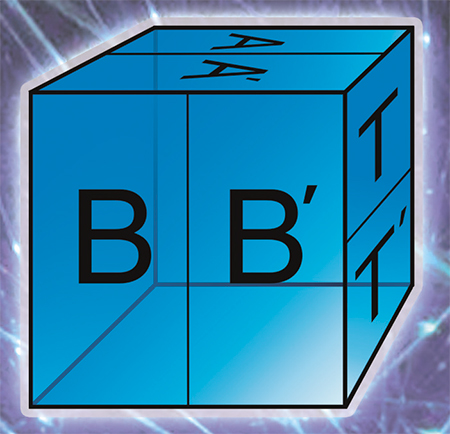 Let us dwell on one more property of rectangular polyhedra. Let D is a regular rectangular dodecahedron in Lobachevsky space. Spanish mathematician H.-M. Montesinos (Hilden et al., 1987) proved the following remarkable theorem:
Let us dwell on one more property of rectangular polyhedra. Let D is a regular rectangular dodecahedron in Lobachevsky space. Spanish mathematician H.-M. Montesinos (Hilden et al., 1987) proved the following remarkable theorem:
"Any closed three-dimensional manifold can be obtained from a finite number of instances of the polyhedron D pairwise identification of their faces.”
Note that in Montesinos' theorem, all faces of glued polyhedra are congruent, and all edges have the same length. Moreover, each edge is surrounded by four, two or one dodecahedron. The first situation is easy to imagine: four rectangular dodecahedrons are glued one after another around a common edge and form a total angle equal to 4 90° = 360°. In the second case, a pair of adjacent faces of one dodecahedron is identified with a pair of adjacent faces of another dodecahedron. The total dihedral angle around an edge belonging to two dodecahedra is in this case equal to 2 90° = 180°. The third option is easy to create by identifying adjacent faces of one dodecahedron by rotating through an angle of 90°.
The presence of edges of the second and third types turns the manifold into diversity with features, or orbifold. In this case, the indicated edges form singular set orbifold. Note that everywhere, except for singular edges, the manifold has Lobachevsky geometry.
3D orbifolds
Euclidean orbifolds
For any three-dimensional Euclidean orbifold there is a fundamental set - a curvilinear polyhedron, from which a given orbifold can be obtained by pairwise identifying (gluing) certain of its faces.
Examples of Euclidean orbifolds are the so-called Borromean rings or a three-dimensional sphere with a singular set node "eight".
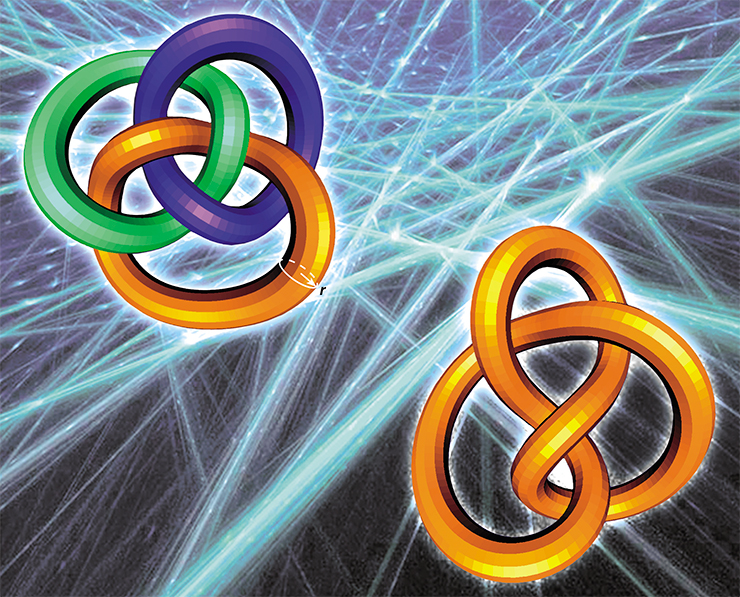
In total, there are 230 closed three-dimensional Euclidean orbifolds - according to the number of crystallographic groups discovered at the end of the last century by the Russian scientist E. S. Fedorov. The structure of Euclidean orbifolds was fully described in W. Dunbar's doctoral dissertation, defended in 1981 at Princeton University, the largest mathematical center in the world.
Spherical orbifolds
A singular set of spherical orbifolds can be the so-called rational node or engagement. It can also be a knotted graph, with three edges coming out of each vertex. In particular, the singular set of a spherical orbifold will be the skeleton of a tetrahedron (edges + vertices) located in a three-dimensional sphere.
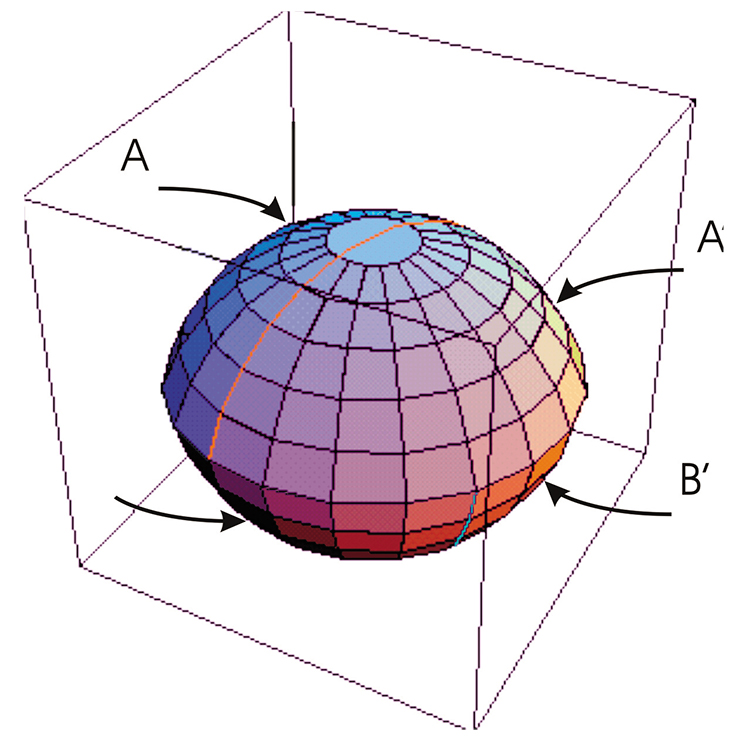
It should be borne in mind that strong knotting of the tetrahedron can spoil the spherical geometry and force the orbifold to have Euclidean, hyperbolic, or one of the synthetic geometries.
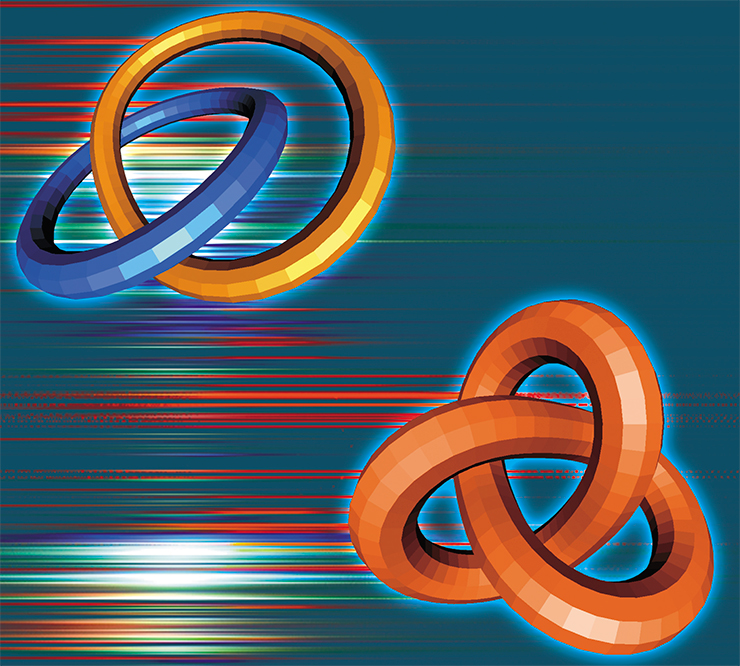
Recently, Australians Professor K. Hodgson and his student D. Heard created computer program, which allows one to calculate the volumes of knotted graphs embedded in a three-dimensional sphere (Hodgson and Heard, 2005). A complete classification of three-dimensional orbifolds in all geometries except hyperbolic is made in the works of W. Dunbar. As in the case of manifolds, hyperbolic geometry is the richest, and a complete description of orbifolds in it has not yet been obtained.
Hyperbolic orbifolds
 Montesinos' theorem implies that every three-dimensional manifold can be turned into a hyperbolic orbifold if a suitable singular set is placed inside it. Since there are infinitely many different varieties, it follows that there are also infinitely many hyperbolic orbifolds.
Montesinos' theorem implies that every three-dimensional manifold can be turned into a hyperbolic orbifold if a suitable singular set is placed inside it. Since there are infinitely many different varieties, it follows that there are also infinitely many hyperbolic orbifolds.
One of the simplest hyperbolic orbifolds is a three-dimensional sphere with a singular set of Borromean rings with a singularity index of 4. Another example is a tightly knotted tetrahedron, all of whose edges have a singularity index of two. The proof of such facts is usually quite complicated and can be carried out using theorems on geometrization obtained by W. Thurston, his students and followers. General principle The proof is as follows: if an orbifold is not Euclidean, spherical or synthetic and satisfies some simple geometric conditions, then it is hyperbolic.
The changes that have occurred in mathematics over the past more than a century and a half have not only expanded its content immeasurably, but also changed it fundamentally. The subject of mathematics now includes any structure that can be investigated by logical reasoning with sufficient rigor and richness of conclusions. Whether it will find application and a prototype in reality is no longer a question for mathematics.
A regular reader of our magazine, Kharkov resident Alexander Ivanovich RYZHENKO is a specialist in the field of aviation, reliability and survivability of aircraft, laureate of the State Prize of Ukraine, author of about forty inventions and more than seventy publications in domestic and foreign publications. A deep interest in Roerich’s heritage inspired the scientist to talk about the categories of space and time, as seen in esoteric knowledge. The factor plays a fundamental role in it manyIria, closely related, but not completely coinciding, with the category manyEria, considered in science. The earthly world is breathtakingly beautiful, it is invitingly complex and multifaceted. Behind it one sees other worlds - Distant, Subtle, Overground - even more complex and alluring... But I so want to reinforce the impulse of heartfelt attraction to their secrets knowledge about these worlds! And the books of Agni Yoga (or Living Ethics), “Letters of Helena Roerich”, supplemented by information from the multi-volume book Facets of Agni Yoga, the work of Daniil Andreev “The Rose of the World” and the data of modern science, which is already close to the discovery and study of the Subtle Worlds, help in this.
Finding himself beyond three dimensions, even the most cold-blooded person will be horrified if his heart is not prepared for the next knowledge.
Fiery World
We must use fiery will to break through the dense sphere of evidence, we must understand time and rise above it, we must think about the secrets of space.
Facets of Agni Yoga
One of the most exciting, but at the same time, the most complex and intimate is the secret multidimensionality of space and time. The three-dimensionality characteristic of the “dense”, physical world that is familiar to us is the shackles of the devil - someone said so. Indeed, the one who shackled human consciousness into three-dimensionality was a real jailer. How could it be possible to hide the other, beautiful, higher dimension!<...>Ancient Wisdom nowhere insisted on three dimensions”, 109. This theme continues and is developed in the Facets of Agni Yoga: “The problems of space and time belong to the category of those that man must sooner or later solve. By Us (the Great Teachers of humanity - A.R.) they have been Resolved, and the past is open to Us, and We See the future. Thus, the problem of space, or rather, distances, that is, proximity and distance, has also been solved. The phenomenon, or concept, of space is so deep and so comprehensive that distances are only a small part of it. A person is surrounded by secrets, they are around him, and he does not notice them, believing that everything is clear and there is nothing to think about. But this is only for the ordinary person. For a true explorer, the world is full of secrets and wonders. True, they are all based on certain Cosmic Laws, but the legality, regularity and harmony of the Universe make it possible for a person to comprehend the depths of the world around him. He can comprehend endlessly, and Infinity itself vouches for the success of the spirit striving for knowledge”, 295.
The three-dimensional world familiar to us
To begin with, let us recall some information about the world familiar to us, which in the books of Agni Yoga is called the dense world. This is the so-called physical world. It has only three spatial coordinates and a single time axis, which in the theory of relativity is proposed to be considered the fourth coordinate of our “space-time continuum.” Three-dimensionality means that any object in the physical world has three dimensions - length, width and height, and the position of any point in three-dimensional space can be uniquely determined by three coordinates x, y, z (Fig. 1). To unambiguously determine the position of a point in space, it is necessary and, at the same time, sufficient to indicate only three numbers - three parameters, that is, three of its coordinates (linear or angular distances from some objects, conditionally chosen as the origin).
All three spatial coordinates are mutually independent, and knowing only two of them, it is impossible to determine the third.
The value of the dimension of space, equal to three, turned out to be justified by heterogeneous physical phenomena- the spectrum of atoms, the propagation of electromagnetic waves, the movement of planets.
E. Kant had the desire to “deduce three-dimensionality”; he tried to connect it with the fact that 3 is the smallest number preceding a composite one.
There is a whole collection of mathematical statements that highlight not just the number 3, but the dimension of space equal to three. But it is also possible to indicate mathematical statements that highlight other values of dimension.
The fact of the three-dimensionality of space is associated with the fundamental properties of the material (physical—Ed.) world.” ( G.E.Gorelik. Why is space three-dimensional? M., Nauka, 1982).
The existence of man in the Universe is determined precisely by the three-dimensionality of physical space and the existing values of its fundamental physical constants. This constitutes the content of the so-called anthropic principle.
At the beginning of the expansion of the Universe, its internal dimensions separated from the external ones. It is no coincidence that the dimension of our space is three. If in two-dimensional space animals would be dispersed along the channel of entry and exit of food, then with a dimension greater than three, gravitational and electrical forces would decrease faster with distance, making the orbits of planets and the orbits of electrons in atoms unstable, leading to their falling to the center or irrevocably moving away from it ( R.F.Polishchuk"Yearbook "Delphis", 2002).
Worlds with a smaller dimension of space
In the books of Agni Yoga, worlds or spheres with a smaller dimension than ours are only mentioned: “The laws of subtle energies are as different from the laws of ordinary energies as the region of two dimensions is from the three-dimensional world. The expansion proceeds in directions not contained in the field of ordinary energies,” 299. In the book by Daniil Andreev “The Rose of the World,” this encyclopedic description of all spaces and subspaces associated with our native Earth, two-dimensional and even one-dimensional worlds are spoken about quite definitely. In any case, consideration of the properties of such a world is useful, since it will help us, by analogy, understand many of the properties of worlds of higher dimension, which are very difficult for the “three-dimensional” human imagination to imagine. With spaces with a smaller number of coordinates than ours, this imagination is mastered quite simply.
One-dimensional the world and the one-dimensional creatures inhabiting it can be imagined as very small beads and tubes strung on an infinitely thin thread and able to move along it. In this case, the thread does not have to be straight - it can be curved, have the shape of a parabola, a spiral or, what is especially sad, a circle. It is even more accurate to imagine one-dimensional space in the form of a tube with an infinitely small diameter internal cavity, in which there are balls and sticks of the same infinitely small diameter. If the substance that composes them is not very dense, close in consistency to a gas or liquid, then they can merge with each other and penetrate through each other. If, in addition, they are transparent, then they can also see the “perspective” - “the light at the end of the tunnel,” the distant, distant light at the far, distant end of the tube, of course, provided that there is something to shine there.
Two-dimensional space is like a thin sheet of paper of infinite length and width, on which hypothetical two-dimensional creatures - “blobs” - can crawl. The surface of a ball, torus, or “donut” is also two-dimensional, since any point on their surface is uniquely determined by two coordinates. Let us note that it is the surface of the ball that is two-dimensional. A sphere is a three-dimensional figure, having (like a cube) its own height, width and length. When talking about a two-dimensional surface, it is better to imagine not a massive round body, but a thin shell, similar to a soap bubble or a balloon.
The examples given are just analogies. There are no strictly two-dimensional objects in our world. Even a very thin sheet of paper, metal foil several atoms thick have their own third dimension. The bodies of the two-dimensional world are devoid of any thickness and cannot be built from the material units of the three-dimensional world. Their elementary particles are not our atoms and electrons, but qualitatively different objects. The elementary particles of our world can be simply represented as microballs moving left and right, forward and backward, up and down, or simultaneously in all three directions. Elementary particles of the two-dimensional world are “micropancakes” moving in one common plane. They can interlock with each other into a flat “mosaic”, but cannot “stand on an edge” in any way. The exit of such a “pancake” or their combination from the original plane is equivalent to disappearance from the “native” two-dimensional world and the transition to the neighboring one, so that the set of two-dimensional worlds is similar to a stack of paper, or balloons inflated one inside the other, or an open book, all the plane-pages of which intersect along one conditional binding line (it is especially convenient to “crawl” on it "from one world to another).
It is a similar model that Daniil Andreev describes in his book, calling the totality of two-dimensional worlds Anticosmos. “The anti-cosmos of all bramfaturas, including Shadanakar, are two-dimensional: they are, as it were, infinite planes. They all intersect with each other in the same line; it could be called the demonic axis of the Galaxy<...>Naturally, it will be visible to any creature living in any of these two-dimensional plane worlds, including those from the corresponding layer of Shadanakar. 2D Shadanakar layer<...>- not the suffering place of human souls in their afterlife, but the abode of most of the demonic creatures of our planet<...>Not devoid of solemnity, but gloomy, this world could not help but seem creepy to any of us. A large number of time coordinates in the presence of only two spatial ones creates a special spiritual stuffiness. For any monad, the process of entering... into this world is painful: it resembles the sensation that occurs when the body is pulled into a tight iron corset...”, book. IV, ch. 1. The burden of existence in two-dimensional worlds is of a nature similar to the discomfort experienced by a person forced to exist in a closed space, without seeing the sky and the sun. This is how submarine sailors and miners feel. Of course, they have a third dimension and can look up or down, but there a view awaits them that is not much different from the walls that confine them to the right and left. This may be the root of mental deviation - claustrophobia, a subconscious fear of enclosed spaces. However, let’s return to D. Andreev’s book: “...the world of one-dimensional space and one-dimensional time. This is the Bottom of Shadanakar, the torment of demonic shelts and a few people - carriers of dark missions<...>It is difficult to imagine how movement can still take place under such conditions. However, it exists on the Day of Shadanakar, and for a conscious being it is painful to the highest degree. It is caused by the need to maintain vitality, since otherwise the creature will be drawn into some kind of hole, leading to places even sadder: to the Bottom of the Galaxy. Every bramfatura of our Galaxy has a similar Bottom, except those that are free from demonic forces; Consequently, there are millions of such “bottoms” in the Galaxy. And just as the two-dimensional cosmic planes of many anti-cosmos<...>cross in common line, all the cosmic lines of the galactic bottoms also intersect at a single vanishing point. This point is located in the Antares star system. It is no coincidence that this star, otherwise called the Heart of Scorpio, served in many mythologies of antiquity and the Middle Ages as the personification of sinister, even diabolical forces. The huge planetary system of this star is the focus of the godless hordes of the Galaxy, their abode in the three-dimensional world<...>From the Bottom of Shadanakar neither the Sun nor other celestial bodies- nothing but the motionless Antares, into which the Bottom rests at one end<...>It is difficult to imagine how a body, the densest of all, is something like the simplest thing that we can imagine: something like a black line<...>Suffering is indescribable,” book. IV, ch. 1.
I think it is not surprising that the creators of Agni Yoga did not consider it necessary to give their readers detailed description similar worlds. Yes, and we touched on them only briefly, since a comparison of the properties of worlds of different dimensions accessible to our imagination will help us, at least by analogy, to understand the features of worlds of a higher dimension than the three-dimensionality that is familiar to us, for “the spheres of invisibility have the same relation to the dense, like the worlds of higher dimensions to the three-dimensional world”, 436.
Worlds with high spatial dimensions
To imagine a space with more than three dimensions is a very difficult, almost impossible task for the human imagination. But the ability to analyze and identify objects of four-dimensional, five-dimensional and other multidimensional spaces is still available. This is done, of course, by the “queen and maid of all sciences”—mathematics.
Let us ask ourselves the question: How does an engineer, when developing drawings of a part of a complex spatial shape, define its contours? On a flat two-dimensional sheet of paper, he draws a whole series of “sections”, each of which is a mental section of a three-dimensional part with a two-dimensional plane: if the part were sawed in this place, smeared with paint and applied to a sheet of paper, an imprint of this shape would be obtained. (This is exactly what resourceful students do when faced with a particularly difficult task in drawing or descriptive geometry: they take a large potato, cut out a “body” of the required shape from it, and with one movement of a kitchen knife perform the given section.)
Knowing a number of characteristic sections of a body, one can imagine its true three-dimensional shape. If all the cross sections are circles and the longitudinal sections are parabolas, then it is a paraboloid of revolution. The mirrors of a photo enlarger, a spotlight, a headlight and a regular flashlight have this shape. If all longitudinal, transverse and horizontal sections of a body are circles, then it is a sphere, the surface of a ball.
Methods of analytical geometry make it possible, using formulas and calculations, to carry out completely similar operations with four-dimensional, five-dimensional bodies and generally having any dimension. What is this four-dimensional object, all three-dimensional sections of which are spheres? It's logical to call it four-dimensional hypersphere. And if a five-dimensional object in all its various sections represents four-dimensional hyperspheres, then this is already five-dimensional hypersphere.
Hyperspheres, like three-dimensional spheres, are described by certain equations, and, oddly enough, their diameter can be measured in ordinary meters, which are familiar to us. Indeed, imagine that we are holding a perfectly round potato in our hands. Let's start cutting this “ball”, making sections with parallel planes. The diameter of the resulting circles will first increase, then decrease. From the middle you will get a circle of the largest diameter. In the same way, by performing mental sections of a four-dimensional hypersphere, we will create balls of ever larger diameter until we get an ordinary three-dimensional ball of the largest diameter. (Naturally, it can be measured by any linear units - meters, millimeters, inches, etc.)
Not only theoretical mathematicians, but also engineers, looking for the optimal ratio of the parameters of the designed machine, as well as specialists in optimal planning, financing, transportation, etc., operate quite freely with multidimensional figures and hyperspaces of a large number of dimensions. After all, practically solving problems of optimal design or planning involves studying the shape of a multidimensional surface, the so-called target function, searching for the deepest troughs-minimums or the highest peaks-maxima (as if it were a journey through very rough terrain. - Red.). If the problem is engineering, the target function can be the weight of the structure, and the axes of multidimensional space can be the parameters on which it depends. Considering dozens and hundreds of options, the engineer “travels” along this multidimensional surface and finds the most suitable option - the highest vertex on the hypersurface of the objective function. Just imagine how many dimensions hyperspace has, in which an aviation design bureau is looking for the optimal ratio of parameters for the wing of a supersonic aircraft!
As for theoretical and experimental physics, it still cannot give an exact answer to the question of whether the space of our Universe has additional coordinate axes besides the three known to us, and if so, how many of these dimensions and subspaces there are with different numbers of proper dimensions has the world around us. Science, although it has achieved some success in studying the multidimensional space-time continuum, but considers the problems of space and time in isolation from the existence of parallel Subtle worlds, which, in principle, limits the possibility of constructing a theory adequate to the surrounding world.
Let us note that a circle is a section not only of a sphere, but also a certain cross section of a cylinder, cone, paraboloid, pear, egg, and even the onion of a church. In the same way, a ball can be a three-dimensional section of a wide variety of high-dimensional hyperbodies. The cross section of a cylinder is a circle, and its longitudinal section is a rectangle; If you cut a cylinder with an inclined surface, you get an ellipse (oval). It’s even more interesting to “cut” the cone. Its cross section is a circle; if you cut it longitudinally exactly along the axis, you get a triangle; if you cut it with the same plane, stepping back from the axis, you get a hyperbola (Fig. 2). But you can still cut obliquely or parallel to the generatrix. Let us emphasize that the same body in different sections has a different shape, but the opposite is also true - the same two-dimensional figure can be a section of different three-dimensional bodies. Multidimensional bodies also have this property. A ball or any oval body can be considered as a three-dimensional section of a four-dimensional object, and in general in one three-dimensional section it can have the shape of a hyperbolic paraboloid, in another - a ball, in a third - also a ball, but of a smaller diameter. Of course, our spatial imagination does not allow us to imagine such a four-dimensional body in its entirety, but it is wonderful that they exist.
Each new dimension makes habitable space incomparable richer and more varied forms bodies existing in them. If in the two-dimensional world these are circles and parabolas, triangles and squares, hexagons, spirals, cardioids, then the shapes of three-dimensional bodies are incomparably more diverse. Stereometry knows spheres and ellipsoids, two-sheet hyperboloids and hyperbolic paraboloids, cubes and tetrahedrons, truncated pyramids and stellate forms of the icosododecahedron.
A sculptor and an architect, when creating their spatial creations, have incomparably greater possibilities than a master of mosaic ornaments. But how vast and varied prospects for creativity open to the spirit in four-dimensional or five-dimensional spaces, how magnificent the creations of the masters of those worlds are - the mind of an inhabitant of a three-dimensional world cannot imagine. We have learned to analyze shapes and construct sections of multidimensional bodies, but we are still unable to experience awe and delight in front of a brilliant work of art, which has one more spatial coordinate, another convexity, relief, just as even a very smart blot living on a page from a school notebook cannot , admire the cut of a diamond. It is unlikely that she is able to appreciate the works of “flat” forms of art of our world, because in the paintings of Rembrandt or N.K. Roerich we are concerned not with the combination of certain colored spots (as in an ornament), but with the depths of space and the play of chiaroscuro on volumetric bodies that display these flat canvases.
In the books of Agni Yoga we can read about another interesting possibility of the inhabitants of multidimensional worlds: “On Earth, a person does not see objects as a whole, but only planes (surfaces. - A.R.) them, facing him with their sides. The rest is completed by his consciousness”, 211. The inhabitants of worlds of higher dimension are able, when looking into our world, to “see objects as a whole”, simultaneously from all sides, completely unknown to us, looking from our four- or five-dimensional world into a three-dimensional one. After all, “space can be considered as a wire to the Invisible worlds, but watching over us”, 060.
As a consolation to two-dimensional blots, we note that, having stereoscopic vision, an inhabitant of a two-dimensional world is quite capable of sensing perspective, assessing the distance to an object and its convexity(by comparing some difference in the images perceived by the right and left eyes, as our brain does). He is also able to see that one object is closer than another, and partially obscures the first, although it is much larger in size. The vision of the world depends not only on the “pictures” captured by the eyes, but (to an even greater extent) on the way they are processed in the mind, which can introduce a number of useful corrections or, conversely, cause optical illusion. This applies equally to both an inhabitant of the two-dimensional world and a creature from our three-dimensionality. “Moving in a train or car, he notices that all the objects that the train passes by come into motion, and, moreover, with at different speeds, depending on their distance from the beholder, but he overcomes this apparent movement in his consciousness. Rails in the distance or the sky and earth on the horizon converge in the same way”, 211.
Let us try to understand another unusual feature of the supermundane worlds, which is repeatedly mentioned in the books of the Teaching of Life. “Distance exists for three-dimensional consciousness and objects of the three-dimensional world”, 005. “In the Subtle World, the concept of distance differs from the earthly one: there are distances, but they are modified and are not measured in kilometers. Proximity and distance are determined by thought and aspiration”, 565. “The laws of space of higher dimensions make the distant close and the impossible possible. Unity in spirit with both living and disembodied entities is possible over the world of three dimensions, when distances disappear and nothing can stop aspiring thought,” 437. The physical essence of shortening distances under the influence of aspirational thought is not revealed in more detail in the books of Agni Yoga. It is not easy to understand this feature - the same analytical geometry, the correctness of which (in relation to the specific objects it considers in three dimensions) so far no one doubts, declares with purely mathematical inexorability: a straight line is the shortest distance between points (in space of any dimension). Indeed: if there are two points on a sheet of paper, then the shortest distance is determined by the straight line between them lying in the same plane. And no matter how clever we are, trying to take advantage of our three-dimensional existence, all the same, any possible trajectories of movement from point to point (with an increase, decrease, along a parabola or a sine wave) will still be longer than a trivial straight line AB, lying in this very plane (Fig. 3a). But this is true as long as we behave mathematically strictly, without going beyond the accepted postulates. If we act non-trivially and “in our hearts” crumple up this very piece of paper or fold it like an accordion (and this will not stop it from being two-dimensional), then it will immediately turn out that in three dimensions we can find a shorter and more direct path than the known one. the blots living there have a line AB(Fig. 3b).
This possible explanation is illustrated even more clearly by an analogy for a one-dimensional world, which looks like a very thin thread with one-dimensional beads and tubes crawling along it. You can also put two dots on this thread. If a line is stretched like a string, inexorable mathematics declares that the shortest distance between points is a straight line lying in this one-dimensional world. What if the thread is wound into a ball? Then the points of contact of neighboring threads, which are very distant from each other according to the concepts of that one-dimensional world, turn out to be very close to each other (from the point of view of three dimensions). Well, now let’s imagine that the thread-yarn has been washed and its skein is hung to dry in a spiral, swaying in the breeze. And so two cute beady dots began to think intently about each other, experiencing powerful mutual sympathy, “spiritual attraction.” But thought, it is possible, is capable of influencing space. The hanging threads, under the influence of the attractive force of these small but powerful magnets, bend, come closer, and... the beads come into contact, being (by the standards of their one-dimensionality) at a huge distance from each other. “It is characteristic of the Subtle World that there is no... distant and near: that which is illuminated by a ray of thought is close, for there thought creates a person’s environment. It is enough to think about a distant object or person, as they are already before your eyes, close up. The magnetism of thought is great,” 168. However, it is fair to explain the phenomenon both by the rapid, almost instantaneous movement of the subtle body to the object of concentration, and by the deformation of the very plastic matter of the Subtle World under the influence of thought, but in the above quote it is said that they are precisely close!
The peculiarities of the relationship between spaces of different dimensions help to understand the statement repeated in Agni Yoga and a number of other teachings that the human spirit is unchangeable and eternal, that no influences from our dense world can destroy the spirit or damage it in any significant way. “Our highest fiery essence is eternal and unchanging, but the consciousness [or soul], collected from the energies accumulated around the main fiery grain, grows and changes. Thus, our fiery grain of spirit is an eternal bearer of constantly changing forms and expressions, generating, in its passage through different spheres and worlds, incessant causes and consequences, developing into a certain form of predestination or fate...”, p.46. The spirit of man, the highest component of his essence, is “not of this world”, belongs to the higher worlds (which have a significantly larger dimension than ours). “Even the astral body operates in another dimension. It is very instructive to compare it with the dimensions of the three-dimensional world<...>Thought puts on the shell of three-dimensionality when it deals with perceptions through dense senses. Outside of them, it is no longer three-dimensional,” 458. Again returning to the analogy of the relationship between the three-dimensional and two-dimensional worlds, one can imagine the spirit of a blot living on a plane in the form of a certain body (for clarity, a cone or a diamond), which comes into contact with the two-dimensional body of the blot only with its top (precisely the point; it’s not for nothing that they say: “The spark of God is within us,” because a spark is like a brightly luminous point). Naturally, no matter what cataclysms occur in a two-dimensional plane, they can only affect a higher-dimensional body in contact with it as a fleeting prick.
What will happen to the imaginary “blot”? A short-term absence of the highest components of the spiritual essence is similar to sleep or short-term oblivion. If the astral and mental bodies remain and, together with the dense body, retain the possibility of active behavior, and the higher components leave, the rational being turns into an “empty shell”, “a living corpse”, “a walking dead man”, 557.
Let's think about what to identify ourselves with, what to mean by “I” - either our mortal body, dense and slow, or the ever-waving astral shell, or the mental body of thought, or the spirit living in the shining worlds of the highest dimension and descending into our world in order to improve and decorate it and at the same time become better, more experienced, wiser. “You should learn to distinguish all three principles with your thoughts. There are actually seven, but for starters and simplification - at least three: dense, subtle, fiery. Consciousness can reside predominantly in any one of them. On Earth it usually resides in the dense, but every emotion is connected with the astral, and thought with the mental principle. And not in the dense world, but above, man dwells in a dream. Thus, even on Earth, consciousness can enter the invisible spheres in which it will reside, throwing off the body. We more often, even while in the body, live in different worlds than it might seem. Plunging into the world of thought, sometimes a person does not see or hear what surrounds him. Where there is thought, there is consciousness. I advise you to direct your thoughts more often higher spheres. This habit will establish a magnetic connection with the higher world”, 262.
Note also that the transition of a spiritual essence from one world to another, the parallel world (layer), is not always as complex as in the dense world familiar to us (which is called Enrof in D. Andreev’s book). “It would be wrong to think, transferring the specific features of Enrof to other layers, that all the barriers separating layer from layer are necessarily as impenetrable as the barriers separating Enrof from the layers of other dimensions. There are, however, barriers that limit one layer, and even less permeable ones, isolating it even more tightly from the rest. But there are few of them. There are much more groups of layers within which the transition from layer to layer requires from a being not death or the most difficult material transformation, like ours, but only special internal states. There are also those from where the transition to neighboring ones is caused by no more effort than, say, the transition from one state of earthly Enrof to another. Several such layers form a system. I am accustomed to mentally call each such system of layers or series of worlds by the Indian term s a k u a la. However, along with sakuals, there are also single layers, like Enrof”, book. II, ch. 3, paragraph 1.
The same feature is mentioned in “Evermundane”, but at the same time another important detail is noted - the changeability of worlds, their evolution, the possibility of gradual rapprochement and simplification of the transition from one world to a parallel one: “The boundaries (of the worlds - A.R.) are usually indistinguishable. The worlds are divided into many states and even enter into one another. Only straight-knowledge can understand the boundaries of such groupings, but it is even more difficult to understand the evolution of worlds. If everything lives by movement, then the state of the worlds cannot exist without movement. We have already talked about the densified astral plane; on the other hand, the corporeal world comprehends the energy of thought and thereby significantly modifies the essence of the flesh. This means that between the Subtle and the corporeal worlds, almost before the eyes of humanity, new states are being formed. Thus, new forms begin to emerge between the Subtle and Fiery Worlds,” 102. “Thoughts about the Distant Worlds, people come from the Earth. The point of departure is correct, but the mistake is that its present state is considered to be, as it were, constant and motionless in its forms, while the thinning of matter itself and the rarefaction of its density in the process of evolution are completely overlooked and not taken into account. The thinning and rarefaction of matter, which occurs due to the fact that matter goes through the path of transmutation through plant, animal and human forms, slowly but persistently and steadily increases its plasticity and mobility. Someday, not only human bodies, but also the matter of the planet, will become a densified astral, then the entire world surrounding a person, thanks to its increased plasticity and rarefaction of matter, will more easily and freely submit to the design of thought”, 367. “The dense world exists and is clearly visible physical vision. The subtle world exists, but we do not see it with dense vision... The New Epoch will be marked by the rapprochement of the worlds. The boundary between them will gradually become thinner until it disappears completely,” 294.
"Layers and whole sakuals They also differ from each other in the nature of the extent of their space. Not all of them have the cosmic extent that Enrof has. No matter how difficult it is to imagine, the space of many of them is extinguished at the borders of the Solar system. Others are even more local: they seem to be contained within the boundaries of our planet. There are even many that are not connected with the planet as a whole, but only with some of its physical layers or sections,” book. II, ch. 3, paragraph 1, (italics - R.A.).
Let us return once again to the question of the differences between the elementary particles that form two-dimensional and three-dimensional bodies. We have already said that three-dimensional “balls” of atoms and electrons of our world cannot act as a material for the formation of two-dimensional bodies, and two-dimensional “pancakes” are unsuitable for three-dimensional space. But in our world there are material objects that can manifest themselves in two dimensions just as successfully as in three dimensions and, obviously, in multidimensionality. These are FIELDS of different physical nature, for example, a magnetic field. It gives a drawing of its lines of force on a flat sheet of paper with iron filings scattered on it. It also forms in three-dimensional space a bizarre “beard” of nails and nuts attracted to a magnet. Obviously, in multidimensional worlds it is capable of forming outlandish constructions from appropriate objects that are sensitive to its influence. Electromagnetic waves of a radio signal are concentrated into a highly directional beam by a parabolic (three-dimensional) radar antenna, but even in the simplest one-dimensional wire antenna they induce an electromotive force. This suggests that objects manifesting themselves in different worlds are, by their nature, closer to stable formations based on fields of different physical natures (for example, ball lightning) than to solid and liquid bodies. "Space contains great fields of unexplored spheres," 418.
What is this “objects” belonging to several worlds at once, capable of existing in them? We will also find the answer to this question in the books of Agni Yoga. This is, first of all, - THOUGHT. “Thought is not limited by anything. There are no barriers or obstacles for her. Like a ray of light, it pierces the entire space of all dimensions." 262. "Mental formations are not subject to the laws of three dimensions, although they have volume, shape, color and even weight."<...>consciousness. They are not three-dimensional. Just as yesterday does not exist on the planet, for it rushed into space, reflected in the rays of the planet, so there is no past, imprinted by memory, in the human body, it is outside it, in the same place as yesterday<...>Financially<...>the past, existing and imprinted in the Invisible world, in the space of other dimensions. The past is imprinted in rays rushing through the abysses of space at incalculable distances, if measured in an earthly way, but do not exist for the fiery consciousness of the spirit,” 005. Let us note once again that “the three-dimensional world is the result of cerebral perception. Even the astral body operates in another dimension. It is very instructive to compare it with the dimensions of the three-dimensional world”, 458.
As for the fourth dimension, it is a property of psychic energy, 542]. In other words, " spatial fire there is a connecting principle between all worlds throughout all manifested space”, 247, p. 331. The use of the term spatial fire in this case is especially important, since it is “the fire of space, being conscious, that turns into psychic energy<...>All divisions into spirit, soul, manas, higher or lower, are essentially only different qualities of one basic energy of fire, life or consciousness, the most high quality which will be the psychic energy”, 005, p. 14-15.
Until now, we have used a visual but simplified idea of the elementary particles of multi-dimensional worlds as solid “balls” and “pancakes”, but in quantum theory the concept particle-wave. It is assumed that all elementary particles (and, consequently, the atoms, molecules, living beings and planets formed from them) have a wave nature and are a kind of clots of energy of a certain field. But a wave cannot exist locally, in a limited area of space: a surge of energy-wave existing in one place moves away from this place in all directions, infinitely decreasing in power, but never reaching zero. Thus, every particle of energy of a particular material object, from a star to an atomic nucleus, exists at any moment in time at any point in space. This means that there is always and everywhere a connection with almost every object in the Universe, if, of course, you have the opportunity to perceive, “communicate” with these micro-energies. More details about particle-waves and the holographic picture of the world can be found in specialized or popular science literature on quantum mechanics. We will try to answer the question: where do mysterious parallel worlds exist and how to get there?
Elena Ivanovna Roerich, explaining the terminology of the Teaching, wrote: “The distant worlds should be understood as other planets in our solar system, [such as] Venus, Jupiter, etc. But when the spheres are mentioned, or the Subtle, Fiery and Higher world, then the spheres are meant -worlds directly surrounding our planet and included in our planetary chain. These are precisely those worlds-spheres from which souls leaving our dense world come and return. The planetary chain, consisting of seven spheres, is one whole, and all spheres-worlds are concentrically combined one within the other and represent certain planes of knowledge or existence. These spheres correspond to the principles in man”, p. 144, italics - A.R.
Involuntarily and unconsciously, even ordinary people find themselves in parallel worlds not so rarely - during sleep, oblivion, under the influence of certain mentally active substances, as well as stress and ecstasy. It is also not forbidden for a person living on Earth to get there, maintaining consciousness and recording his actions in memory: the main thing is to think about it, strive for it, with all your heart desire to bring conscious benefit in these worlds, to work there for the Common Good. “If you can distinguish layers of thought, then you can also sense different types of activity. At first all activity seems to take place on the earthly plane. Afterwards, among the so-called dreams, straight-knowledge is separated as a separate activity, occurring not only on the earthly plane. This is how the first awareness of the entry of other worlds into our existence is formed. Then, already in a state of full wakefulness, momentary absences that are not associated with any disease begin to be noticed. In this way, the connection between the worlds and our participation in them is outlined even more deeply. It is not easy for consciousness to grasp the idea of the invisible worlds; due to our dense shell, it is very difficult for us to recognize all the possibilities outside our vision. You need to get used to thinking about entire worlds that really exist. The subtle world is not only our state, it is precisely the whole world with all the possibilities and obstacles. The phenomenon of life in the Subtle World is not far from the earthly one, but on a different plane,” 105. “You cannot jump from one state to another without fiery hardening. Thus, it is impossible to accept the beauty and solemnity of the Subtle World without timely refinement of the heart. You can stand senselessly in the dark in front of the most beautiful works of art, but the darkness is in us! And the spatial Fire can be ignited only by the Fire of the heart. It has been said many times that the great Fire is revealed by our heart. So, if someone remains in the dark, they only have themselves to blame. But it is terrible to remain in the darkness of the fourth dimension, and all subsequent dimensions turn into terrible grimaces without illumination by the Fire of the heart,” 030. “The wealth and possibilities of spatial life open up before the spirit, which can already consciously go out into the spatial ocean. But for this it is necessary that his other bodies also be formed. For a formed fiery body, space is open and accessible”, 437. Namely, “one must use fiery will to break through the dense sphere of evidence, one must understand time and rise above it, one must think about the secrets of space”, 269.
Harkov city
(End to follow)
Note
According to modern science, stable formations of wave nature are SOLITONS as a manifestation of the action of “standing” waves that arise due to a combination of special physical circumstances, in particular, as a result of interference. One might think that in general all the objects of our physical world are nothing more than soliton-like formations of subtle wave processes, even of a yet unknown nature. — Note edit
Saturday, 7. December 2013 - 14:40
Any schoolchild will tell you that you can move up, down, and also left, right, forward and backward. In total - six paths. The higher up, the further from the bottom, and the same is true for the other sides of the movement. Thus, there are only three independent directions in the world in which we can move - as far as gravity and obstacles in the form of physical objects allow. This fact is so obvious that we rarely ask ourselves: why is this so?
Scientists have long been trying to uncover the mystery of the three-dimensionality of space, but so far without success. Our best physical theories say absolutely nothing about why there are three dimensions and not two, four or 5.2. Moreover, the further we delve into the study of this issue, the more we are convinced that three is least suitable for the role of a “magic number”. But perhaps in our search for truth we have gone too deep into the jungle of science. results latest research they say that the answer may lie right on the surface - in physical laws that have long been known to us.
Everything for us!
Some scientists adhere to the anthropic principle: there are just enough measurements to allow us to ask such questions. Others think that the answer lies in physics, we just haven't found it yet. Today, researchers are trying to build a theory of quantum gravity that could combine general relativity with quantum mechanics, which describes everything except gravity. This would help us understand what happened in the first moments of the Universe's life, when it was a tiny clot of quantum chaos. Perhaps the three-dimensionality of the surrounding world, like the one-dimensionality of time, arose even earlier. “It is now generally accepted that spacetime has a beginning,” says Gary Gibbons of the University of Cambridge (UK).
It is extremely difficult to test this hypothesis. In huge accelerators such as the Large Hadron Collider at CERN near Geneva, Switzerland, scientists collide high-energy particles in an attempt to understand how our universe began, but no experiment has brought us any closer to quantum gravity.
The situation is complicated by the fact that most of the most promising modern theories work in any space other than three-dimensional. Thus, string theory requires the introduction of at least six more dimensions. Another concept, called causal dynamic triangulation, describes a quantum system of two-dimensional elements that evolves to the level of macroscopic 3D space. In the theory of loop quantum gravity, the space-time continuum is not uniform, but grainy or foamy when viewed under very high magnification. “And this is taken for granted,” says one of the founders of this approach, Carlo Rovelli from the University of Aix-Marseille (France). – Science in currently does not have the tools that would allow us to find out why there are exactly three dimensions.”
A different point of view is shared by Markus Muller from the Perimeter Institute in Waterloo (Ontario, Canada). In his opinion, we are quite capable of unraveling this mystery, and the answer should be sought in the already existing theory.
Quantum mechanics certainly describes the physical world with stunning accuracy, but it often contradicts our usual understanding of reality. For example, it allows objects to be in two places or in two states at the same time and denies the existence of cause-and-effect relationships. Usually, physicists simply ignore such things or find very bizarre explanations for them - from the strange influence of experimenters on the results of an experiment to the existence of many bifurcating universes.
Müller found a way to get around these, as he put it, “philosophical traps”: he proposed to derive the fundamentals quantum mechanics from what practical experience tells us. More than a century ago, we understood the essence of the laws of thermodynamics in the same way, observing what could and could not happen in nature. Thus, it is impossible to make a perpetual motion machine that would produce energy from nothing. “You have to think carefully about what the formulas mean and what is feasible in reality,” the scientist says.
Together with his colleague Luis Masanes from the University of Bristol (UK), Müller considered a situation in which the sender and recipient exchange data encoded in quantum states. This principle underlies a real-life top-secret encryption technique called “quantum cryptography.” In the course of numerous experiments, it was found that there is a connection between the information available to the sender and the recipient that goes beyond what we are accustomed to consider possible. Change the quantum state of the photons at one end, and the same changes will instantly occur at the other.
The researchers began with a few "reasonable" assumptions about how the material world around the recipient and sender functions. Let's say it has a certain number of dimensions, including time, as well as a certain information transmission channel. In addition, at least some of the physical processes in the Universe are random, although scientists do not explain to what extent. From here comes a harmonious mathematical proof with unexpected consequences. Quantum theory is not only the only theory that correctly predicts the relationship between randomness and order observed in nature. It also works only if space has three dimensions (New Journal of Physics, vol. 15, p. 053040).
We are here because we are here
Life in a space with fewer than three dimensions would be completely different. Our brain is made up of neurons communicating with each other in 3D; our digestive tract is a series of cylindrical tubes; even the DNA molecule looks like a three-dimensional spiral. Two-dimensional life would be too limited to allow us to discuss the very problem of the multidimensionality of space.
There are also arguments against more dimensions. In the world where you and I live, the force of gravity changes in inverse proportion to the square of the distance between objects. In a 2D universe it would change proportionally to the distance itself, and in a 4D world it would change proportionally to its cube. In both cases, the orbits of celestial bodies would be unstable: a banal impact from an asteroid could throw the planet into deep space or towards the parent star. The same thing would happen at the level of electrons and atoms. Thus, the number of measurements is physical quantity, which, like electromagnetic and gravitational constants, determines the possibility of the existence of highly developed life. “I think this is the only reasonable explanation,” says Leonard Susskind of Stanford University in California (USA). Atoms and molecules would not exist as we know them if space had more or less dimensions.
Many experts are not satisfied with such explanations. “This is absolute nonsense,” says Carlo Rovelli from the University of Aix-Marseille (France). “If we lived in a six-dimensional world, there would be many arguments in favor of the fact that six is the only possible number.” Critics also note that, unlike natural constants, the degree of multidimensionality of space is a perfect integer. It is difficult to imagine that such a value could be the result of some chaotic cosmic process
Origins of reality
Perhaps it's just a mathematical coincidence. Quantum states are described not by one-dimensional real numbers lying on the same line, but by two-dimensional complex ones, which are points on a plane. The set of these numbers, organized in such a way that a three-dimensional sphere is obtained, provides a complete description of objects capable of being in two states simultaneously (for example, photons).
Muller believes that this coincidence is not accidental. In his opinion, there is an inextricable connection between the geometry of space and the degree of probability inherent in quantum theory. If so, then the roots of relativity and quantum mechanics lie in the way information is exchanged in the Universe, giving us a hint where to look for the key to a unified theory. “This suggests to us that an important part of quantum gravity is a concept called ‘information,’” the scientist says.
Similar arguments are given by Austrian scientists Borivoj Dakich and Kaslav Bruckner. They prove that quantum mechanical laws can only be valid in three dimensional world- at least in one like ours, where microscopic objects interact with each other in pairs. If three or more quantum systems could simultaneously influence each other, then the existence of universes with a large number of dimensions would be quite possible (arxiv.org/abs/1307.3984).
However, Dorje Brody from Brunel University in London (UK) believes that such arguments should be treated with caution. “It all starts with statements that seem to be beyond doubt, but then they begin to acquire additional conditions that come from nowhere,” he notes. “There still has to be a moment when the rabbit hits the hat, so to speak.” The scientist believes that all our conclusions in this case depend entirely on the mathematical language we use. For example, some representations of quantum mechanics do not use two-dimensional complex numbers, but four-dimensional (quaternions) and eight-dimensional (octonions). Last year, Brody and his colleague Eva-Maria Graefe of Imperial College London showed that the quaternion formulation naturally increases the number of dimensions to five, and the octonion formulation to nine (Physical Review D, vol. 84, p. 125016).
So, are we left with nothing again? Not really. The fact is that such representations predict slightly different experimental results compared to traditional theory, including different degrees of correlation between particles. If quantum interactions are indeed the source of the multidimensionality of space, this points us to new ways in which we can arrive at the answer without spending money on facilities like the LHC, Brody says.
Another Imperial College expert, Terry Rudolph, says this gives us plenty of room for research, but warns against blindly following fashion trends. “Remember how at one time they tried to describe everything in the world from the perspective of chaos theory,” he says. The scientist is inclined to think that the degree of multidimensionality of space is a concept too human to be explained. The same point of view was held by the famous 18th century philosopher Immanuel Kant, who considered space to be nothing more than a subjective form of sensibility, the only meaning of which is that it allows us to establish relationships between objects. “Perhaps three-dimensionality is just a variable that our ape ancestors found useful in finding bananas,” Rudolph suggests.
Newton and Einstein, both insistent on the reality of space, would likely have approved of modern attempts to explain such a basic characteristic as the number of dimensions. However, it is likely that we will eventually be forced to accept it as a given, says philosopher Craig Callender of the University of California, San Diego (USA): “Three-dimensionality may remain, so to speak, the unexplained explainer.”
- then they would grow into two circles, as we “descended” through their universe,
- the circles would grow until they united into an oval,
- then other circles (fingers) would appear next to them,
- would grow into two large circles (hands, arms), together with an oval,
- then everything would merge into one large part of our shoulders,
- then it would shrink, grow and dissolve into our necks and heads.
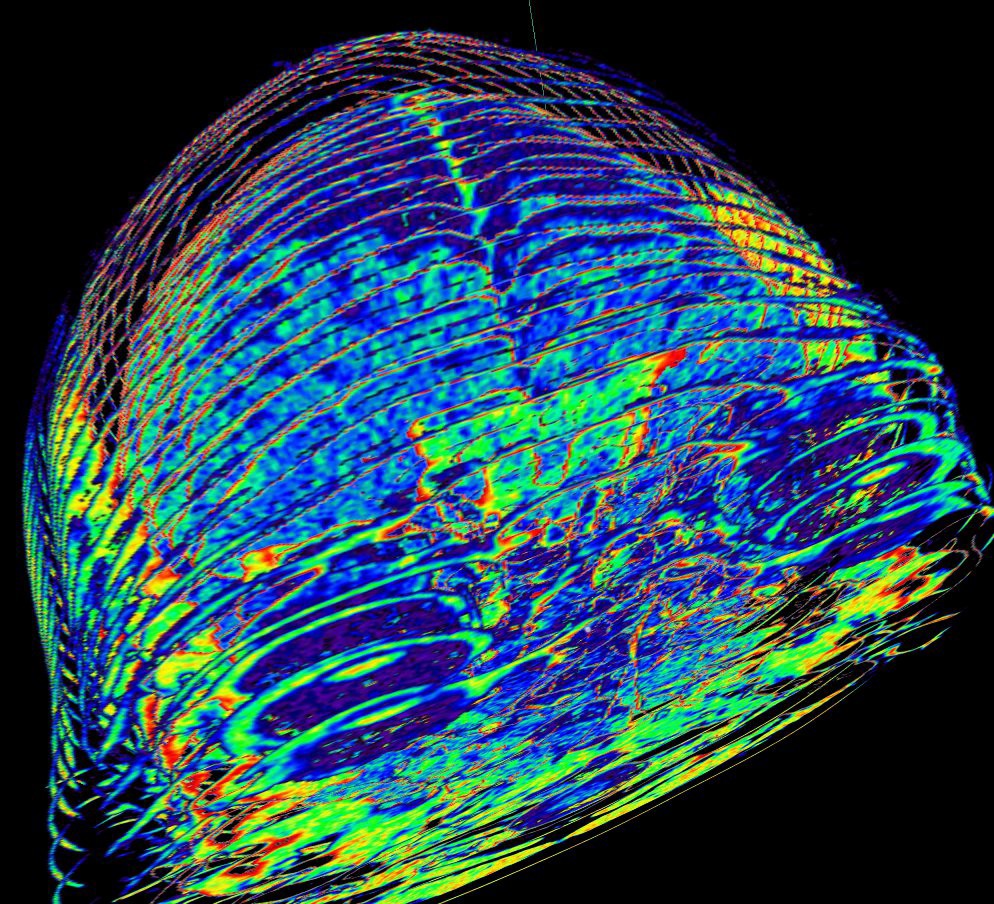
Fortunately, there are no four-dimensional beings living in our Universe, since they would seem to us to be divine beings who ignore physical laws. But what if we turn out to be not the most multidimensional creatures in the Universe, and the Universe itself has more dimensions than it has now? It's worth noting that this is entirely possible; it has been proven that in the past the Universe could have had more dimensions.
In the context of general relativity, it is quite simple to construct a space-time framework in which the number of “large” (that is, macroscopic) dimensions would change over time. Not only have you been able to have more dimensions in the past, but you may well have the chance to do so in the future; you could actually construct a space-time in which this number would fluctuate, changing up and down over time, over and over again.
For starters, everything is cool: we can have a Universe with a fourth - additional - spatial dimension.
So that's cool, but what will it look like? We don't usually think about this, but the four fundamental forces - gravity, electromagnetism and the two nuclear forces - have these properties and forces because they exist in the dimensions that our Universe has. If we were to decrease or increase the number of dimensions, we would change the way force field lines propagate, for example.
If this affected electromagnetism or nuclear forces, there would be a catastrophe.
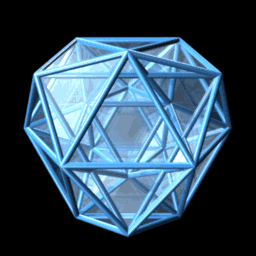
Imagine that you are looking at an atom, or inside an atom, looking at the atomic nucleus. Nuclei and atoms are the building blocks of all the matter that makes up our world, and are measured in the smallest distances: angstroms for atoms (10^-10 meters), femtometers for nuclei (10^-15 meters). If you were to allow these forces to "flow" into another spatial dimension, which they could only do if that dimension became large enough, the laws of interaction that govern the operation of these forces would change.
In general, these forces will have more "room" to run away, and therefore will become weaker faster over a distance if there are more dimensions. For nuclei, this change will not be so bad: the size of the nuclei will be larger, some nuclei will change their stability, become radioactive, or, on the contrary, get rid of radioactivity. That's okay. But with electromagnetism it will be more difficult.
Imagine what would happen if suddenly the forces binding electrons to nuclei became weaker. If there were a change in the strength of this interaction. You don't think about it, but at the molecular level the only thing holding you back are the relatively weak bonds between electrons and nuclei. If you change this force, you change the configurations of everything else. Enzymes denature, proteins change shape, ligands separate; The DNA will not be encoded into the molecules it should be.
In other words, if the electromagnetic force changes as it begins to spread into a large fourth spatial dimension that reaches the size of an angstrom, people's bodies will instantly fall apart and we will die.
But all is not lost. There are many models - mostly developed within string theory - where these forces, electromagnetic and nuclear, are limited to three dimensions. Only gravity can pass through the fourth dimension. What this means to us is that if the fourth dimension grows in size (and therefore in consequences), gravity will "bleed" into the extra dimension. Consequently, objects will experience less attraction than what we are used to.

All this will lead to the manifestation of “strange” behavior in various things.
Asteroids, for example, that are stuck together will fly apart because their gravity is not strong enough to hold the rocks together. Comets approaching the Sun will evaporate faster and show even more beautiful tails. If the fourth dimension grows large enough, gravitational forces on Earth will be greatly reduced, causing our planet to grow larger, especially along the equator.
People living near the poles will feel as if they are in a reduced-gravity environment, while people at the equator will be in danger of flying into space. At the macro level, Newton's famous law of gravity - the inverse square law - will suddenly become an inverse cube law, greatly decreasing the force of gravity with distance.

If the measurement reaches the distance from the Earth to the Sun, everything in the solar system will be untied. Even if this lasts only a couple of days a year - and if gravity is normal every three months - our solar system will completely collapse in just a hundred years.
There would come a time on Earth when we would not only be able to move through space in an “additional” way, when we would not only have an additional “direction” beyond up-down, left-right, and back-and-forth, but also when the properties of gravity would change for the worse. We would jump higher and further, but the consequences for the now stable Universe would be apocalyptic.
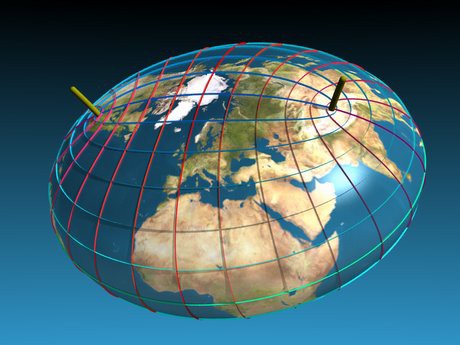
Therefore, it’s definitely not worth dreaming about the appearance of the fourth dimension. However, there is also a positive note. We wouldn't have to worry about global warming, since increasing distance from the Sun would greatly cool our world, faster than rising atmospheric carbon dioxide warms it.
What would the fourth spatial dimension look like? Ilya Khel
